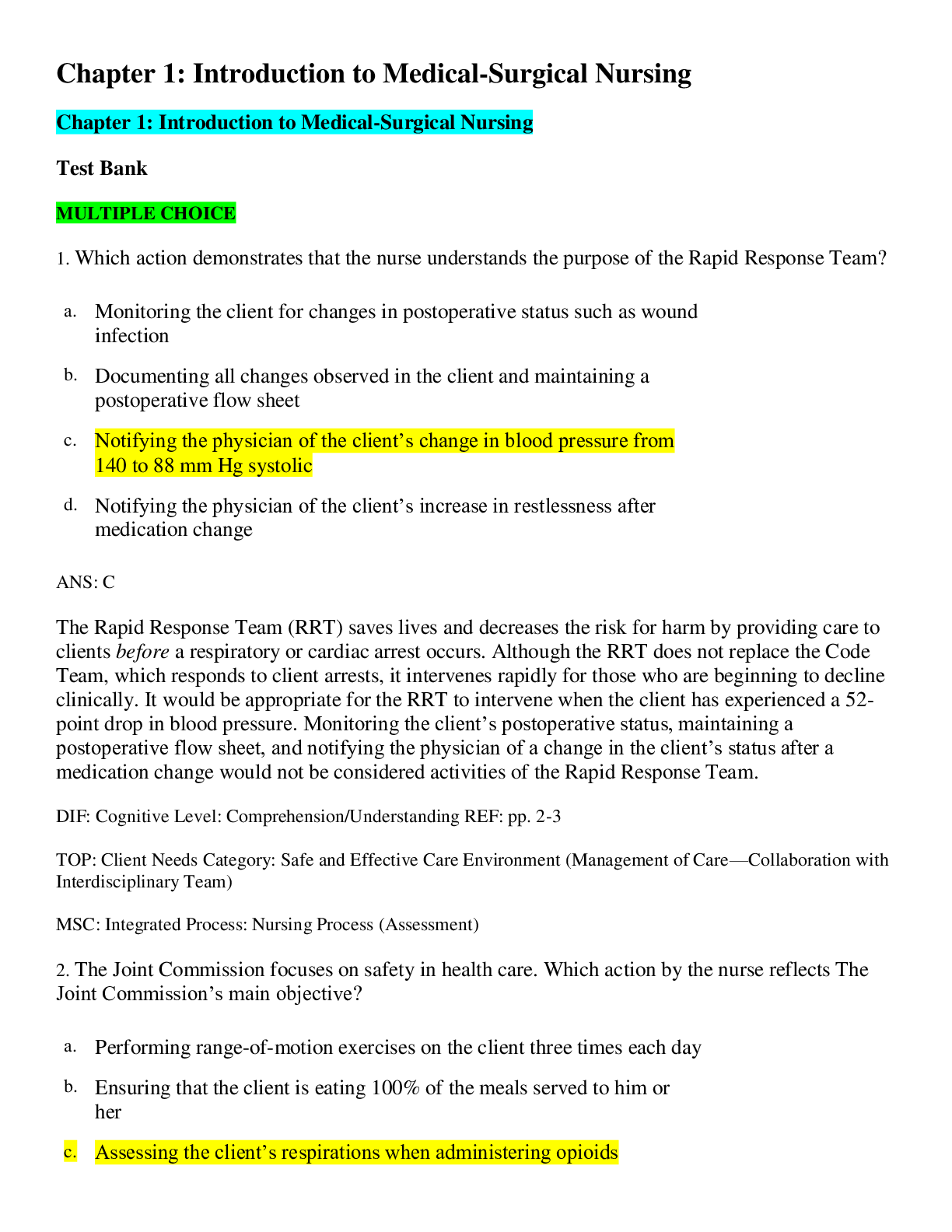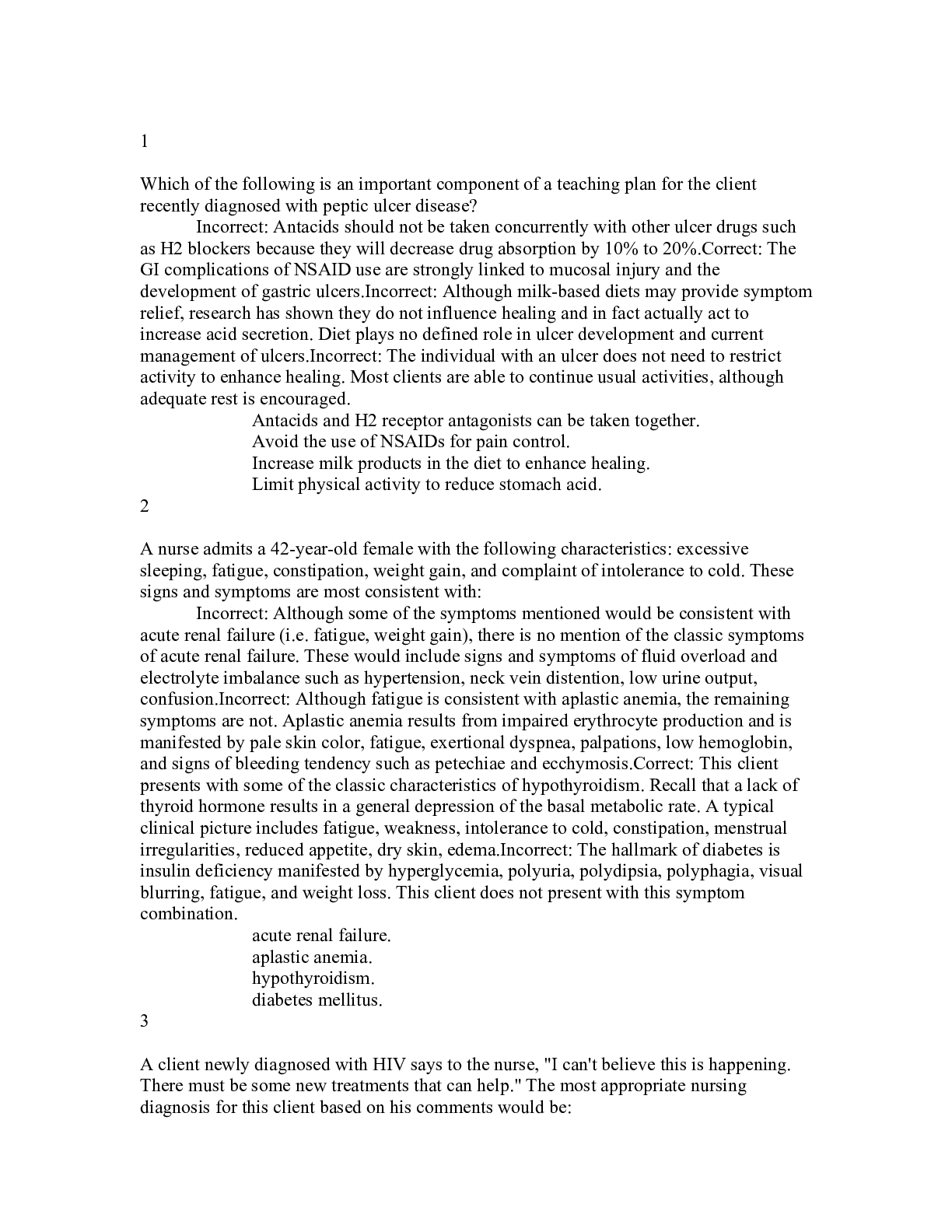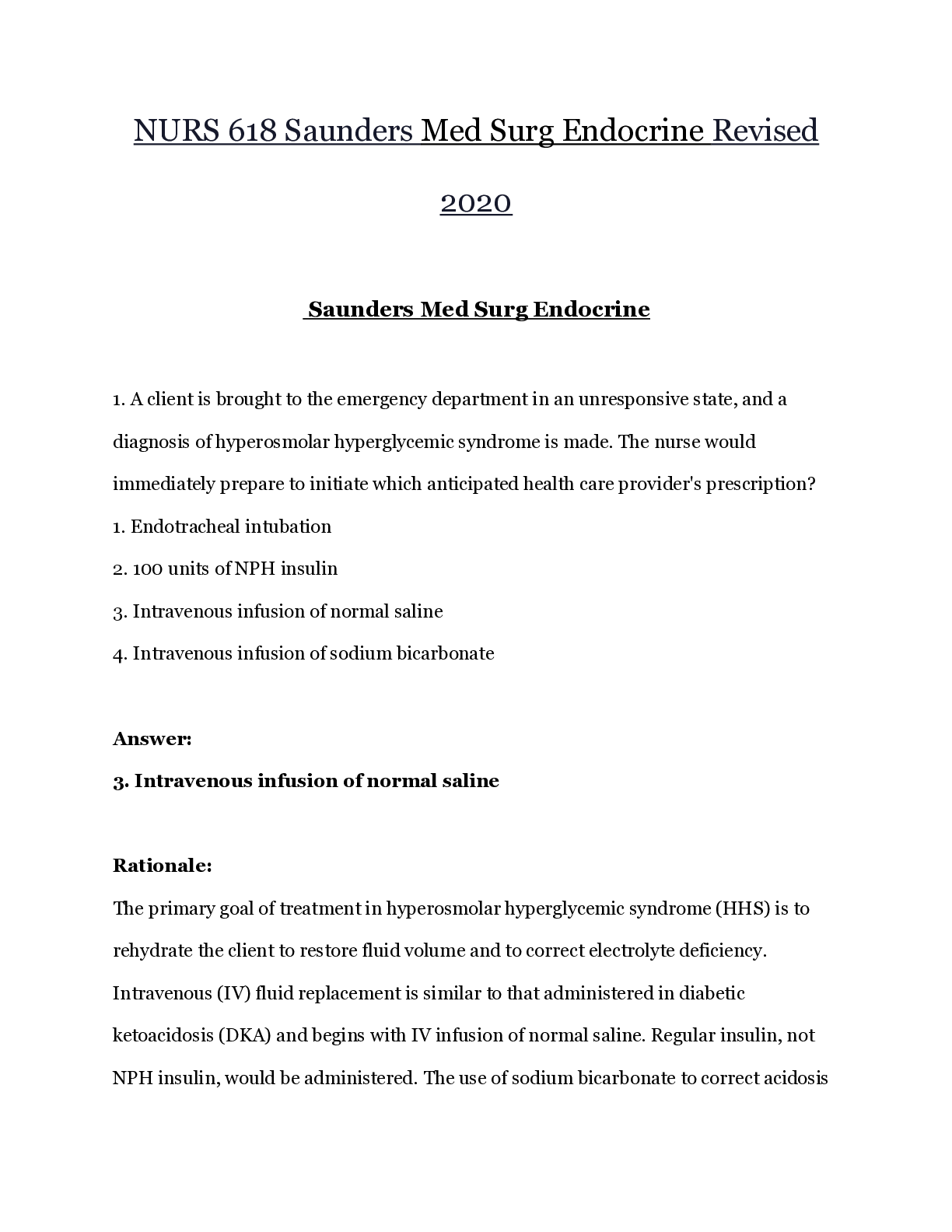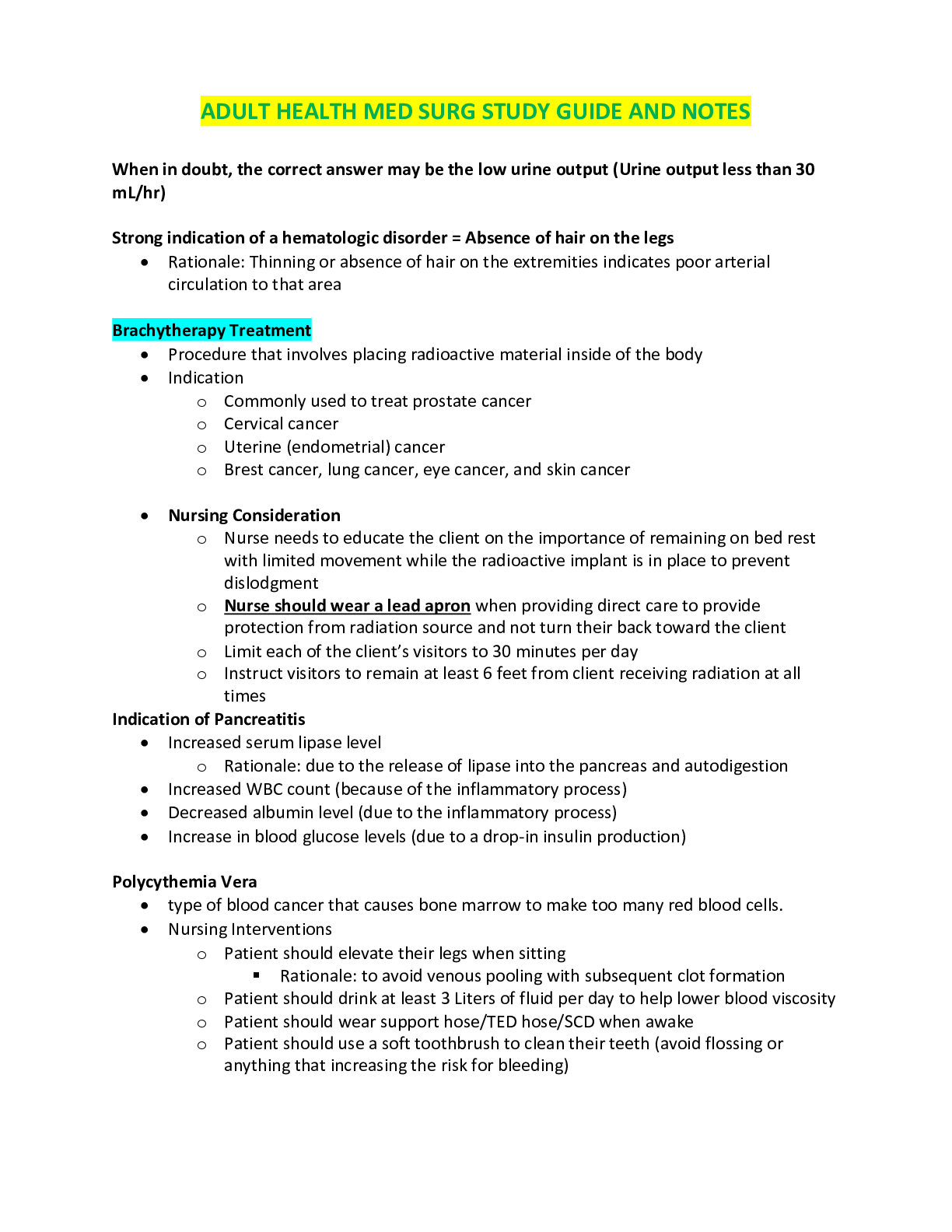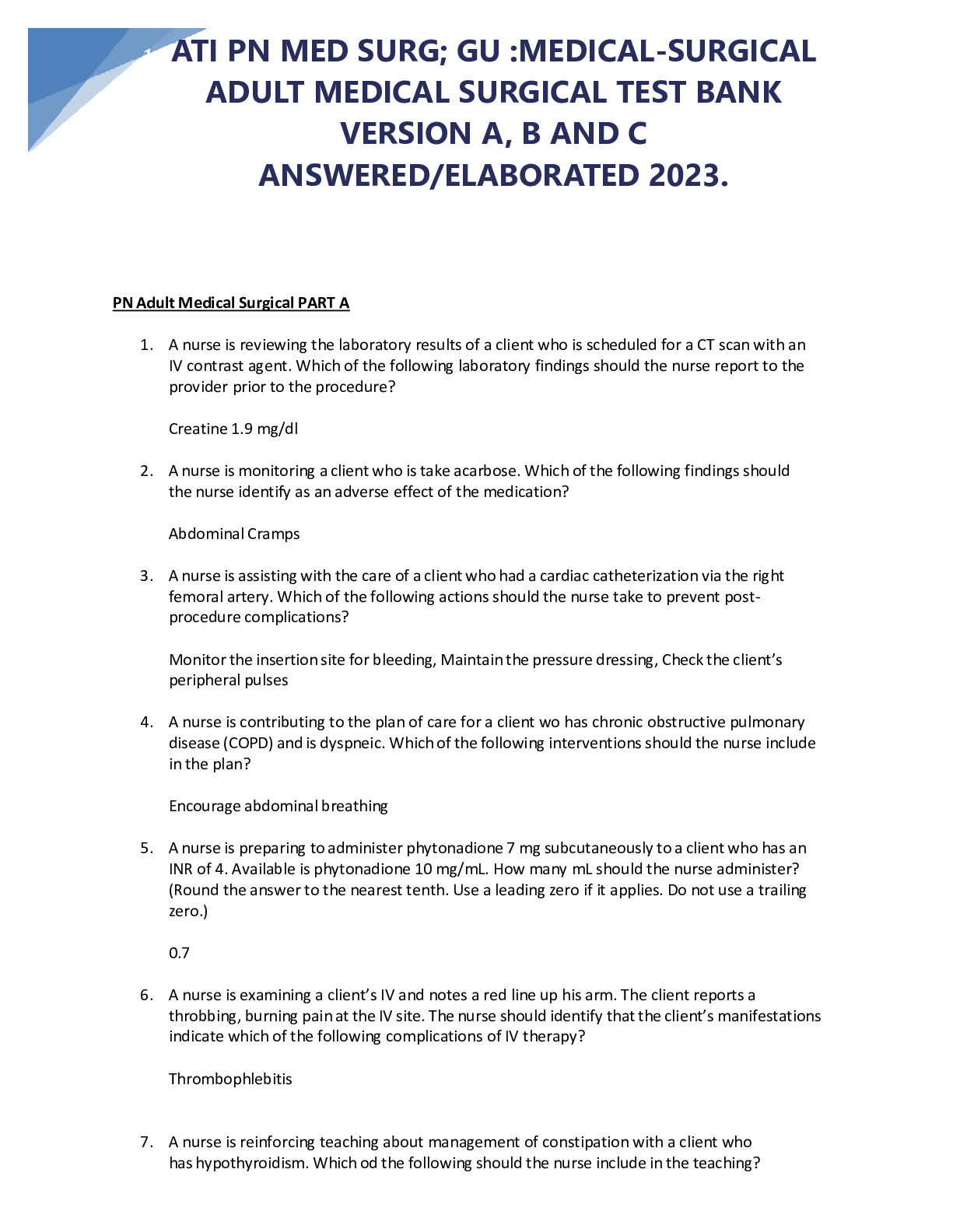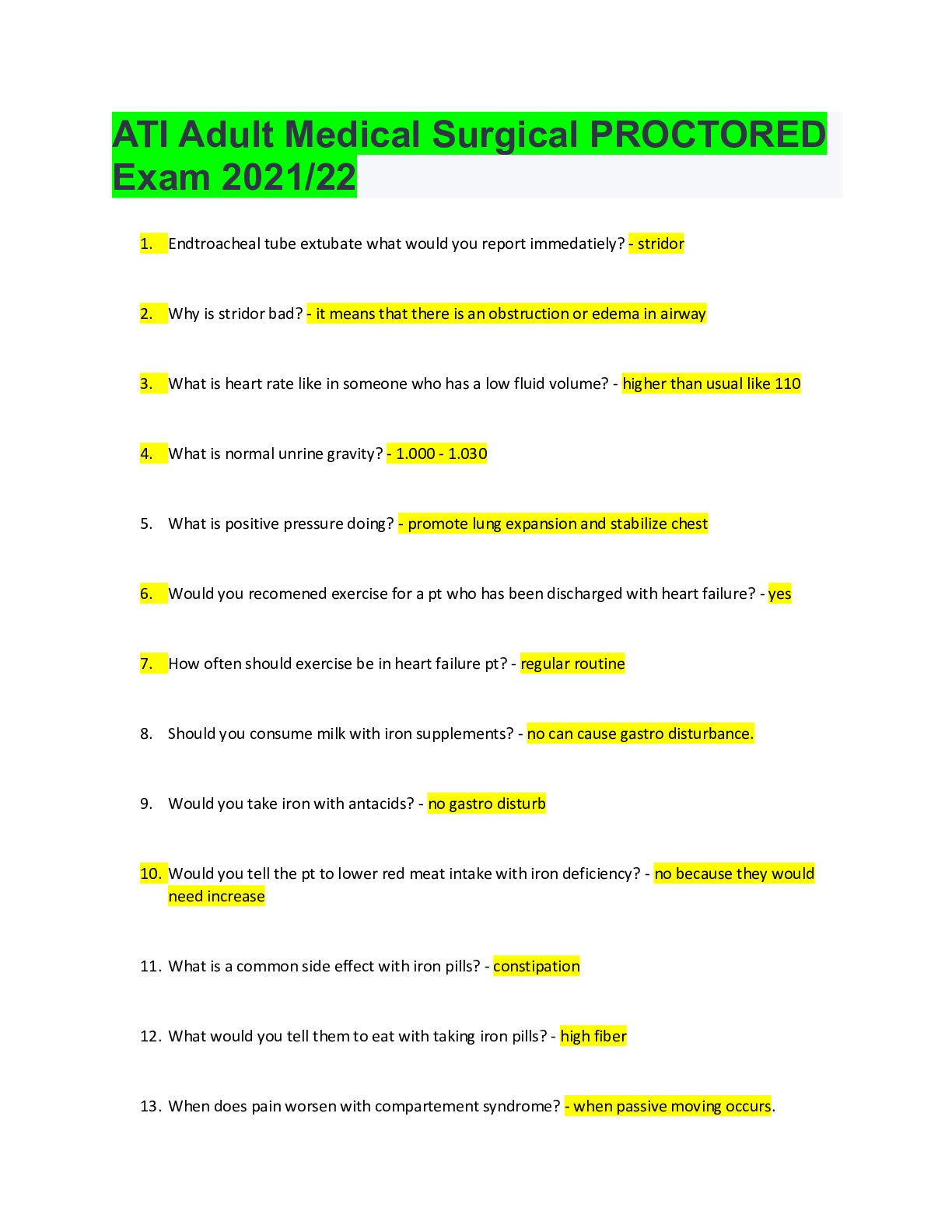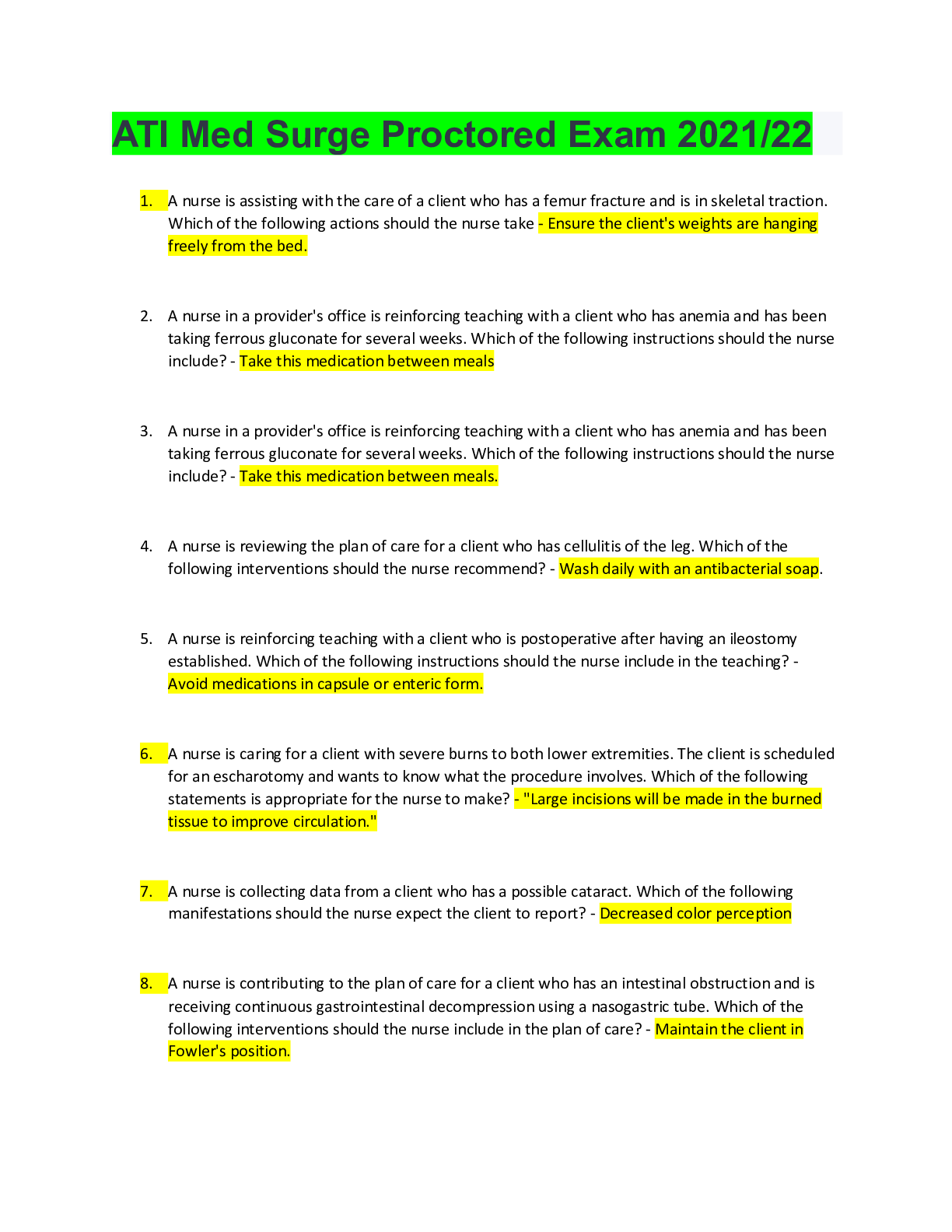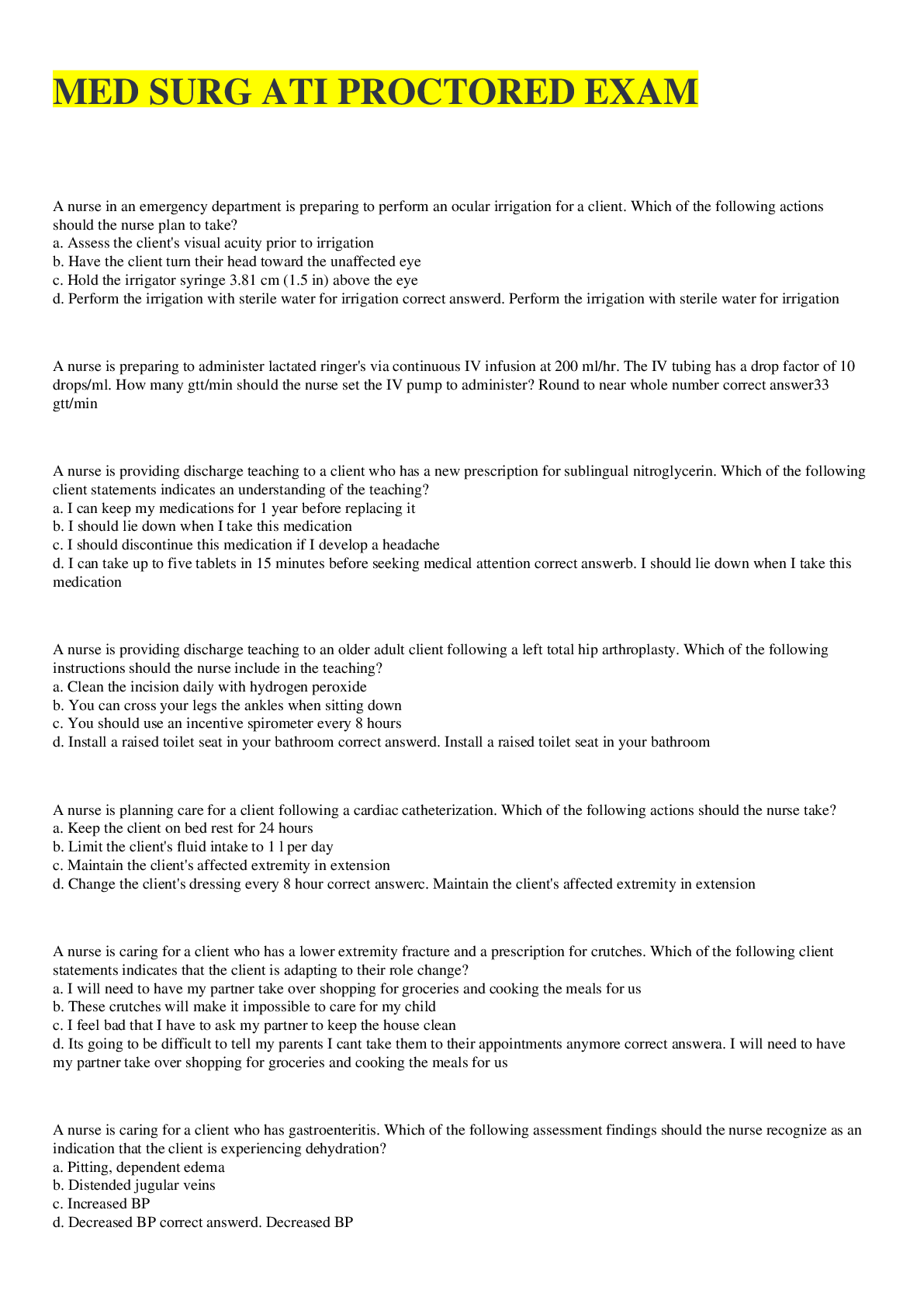*NURSING > MED-SURG EXAM > Test Bank for Medical Surgical Nursing 7th Edition by Linton (2)-Test Best Solution to Ace Your Exam (All)
Test Bank for Medical Surgical Nursing 7th Edition by Linton (2)-Test Best Solution to Ace Your Exam
Document Content and Description Below
Chapter 01: Aspects of Medical-Surgical Nursing Linton: Medical-Surgical Nursing, 7th Edition MULTIPLE CHOICE 1. What provides direction for individualized care and assures the delivery of accurate... , safe care through a definitive pathway that promotes the client’s and the support persons’ progress toward positive outcomes? a. Physician’s orders b. Progress notes c. Nursing care plan d. Client health history ANS: C The nursing care plan provides direction for individualized care and assures the delivery of accurate, safe care through a definitive pathway that promotes the client’s and the support persons’ progress toward positive outcomes. DIF: Cognitive Level: Comprehension REF: p. 2 OBJ: 1 TOP: Nursing Care Plan KEY: Nursing Process Step: Planning MSC: NCLEX: Physiological Integrity: Reduction of Risk 2. The nurse is performing behaviors and actions that assist clients and significant others in meeting their needs and the identified outcomes of the plan of care. What is the correct term for these nursing behaviors? a. Assessments b. Interventions c. Planning d. Evaluation ANS: B Caring interventions are those nursing behaviors and actions that assist clients and significant others in meeting their needs and the identified outcomes of the plan of care. DIF: Cognitive Level: Comprehension REF: p. 3 OBJ: 1 TOP: Interventions KEY: Nursing Process Step: Planning MSC: NCLEX: Physiological Integrity: Reduction of Risk 3. The nurse understands the importance of being answerable for all actions and the possibility of being called on to explain or justify them. What term best describes this concept? a. Reliability b. Maturity c. Accountability d. Liability ANS: C Accountability means that a person is answerable for his or her actions and may be called on to explain or justify them. DIF: Cognitive Level: Comprehension REF: pp. 6-7 OBJ: 3 | 5 | 7TOP: Accountability KEY: Nursing Process Step: N/A MSC: NCLEX: Physiological Integrity: Reduction of Risk MULTIPLE RESPONSE 1. The nurse manager is providing an inservice about conflict resolution. What modes of conflict resolution should be addressed? (Select all that apply.) a. Suppression b. Accommodation c. Compromise d. Avoidance e. Collaboration f. Competition ANS: B, C, D, E, F The modes of conflict resolution include accommodation, collaboration, compromise, avoidance, and competition. DIF: Cognitive Level: Knowledge REF: p. 7|p. 8|Table 1.1 OBJ: 7 TOP: Conflict Resolution KEY: Nursing Process Step: N/A MSC: NCLEX: N/A 2. What are the characteristics of an effective leader? (Select all that apply.) a. Effective communication b. Rigid rules and regulations c. Delegates appropriately d. Acts as a role model e. Consistently handles conflict f. Focuses on individual development ANS: A, C, D, E Characteristics of an effective leader include effective communication, consistency in managing conflict, knowledge and competency in all aspects of delivery of care, effective role model for staff, uses participatory approach in decision making, shows appreciation for a job well done, delegates work appropriately, sets objectives and guides staff, displays caring, understanding, and empathy for others, motivates and empowers others, is proactive and flexible, and focuses on team development. DIF: Cognitive Level: Comprehension REF: p. 6 OBJ: 5 TOP: Leadership KEY: Nursing Process Step: N/A MSC: NCLEX: N/A COMPLETION 1. _________ is defined as the process by which information is exchanged between individuals verbally, nonverbally, and/or in writing or through information technology. ANS: CommunicationCommunication is defined as the process by which information is exchanged between individuals verbally, nonverbally, and/or in writing or through information technology. DIF: Cognitive Level: Knowledge REF: p. 2 OBJ: 2 TOP: Communication KEY: Nursing Process Step: N/A MSC: NCLEX: N/A 2. _________ is the collection and processing of relevant data for the purpose of appraising the client’s health status. ANS: Assessment Assessment is the collection and processing of relevant data for the purpose of appraising the client’s health status. DIF: Cognitive Level: Knowledge REF: p. 2 OBJ: 1 | 2 TOP: Assessment KEY: Nursing Process Step: N/A MSC: NCLEX: N/A 3. _________ is concerned with the ethical questions that arise in the context of health care. ANS: Bioethics Bioethics is concerned with the ethical questions that arise in the context of health care. DIF: Cognitive Level: Knowledge REF: p. 4 OBJ: 3 TOP: Bioethics KEY: Nursing Process Step: N/A MSC: NCLEX: N/A 4. Place the corresponding letter to each stage of conflict in the correct order. _________ (Place the events in the appropriate sequence with capital letters. Do not separate answers with a space or punctuation. Example: ABCD.) a. Outcomes b. Conceptualization c. Frustration d. Action ANS: CBDA The stages of conflict in order are frustration, conceptualization, action, and outcomes. DIF: Cognitive Level: Comprehension REF: p. 7 OBJ: 7 TOP: Conflict KEY: Nursing Process Step: N/A MSC: NCLEX: N/A 5. Place the corresponding letter to each key step in solving an ethical dilemma in the correct order. _________ (Place the events in the appropriate sequence. Do not separate answers with a space or punctuation. Example: ABCD.) a. Negotiate a plan. b. Clarify values. c. Ask if it is an ethical dilemma.d. Verbalize the problem. e. Gather information. f. Identify possible courses of action. g. Evaluate the plan over time. ANS: CEBDFAG The key step of solving an ethical dilemma in order are ask the question, is it an ethical dilemma, gather information, clarify values, verbalize the problem, identify possible course of action, negotiate a plan, and evaluate the plan over time. DIF: Cognitive Level: Analysis REF: p. 4 OBJ: 3 TOP: Ethical Dilemma KEY: Nursing Process Step: N/A MSC: NCLEX: N/AChapter 02: Medical-Surgical Practice Settings Linton: Medical-Surgical Nursing, 7th Edition MULTIPLE CHOICE 1. While a home health nurse is making the entry to a service assessment on a homebound patient, the spouse of the patient asks whether Medicare will cover the patient’s ventilator therapy and insulin injections. What is the best response by the nurse? a. “Yes, Medicare will cover both the ventilator therapy and the insulin injections.” b. “No, Medicare will not cover either of these ongoing therapies.” c. “Medicare will cover the ventilator therapy, but it does not cover the insulin injections.” d. “Medicare will cover the ongoing insulin therapy, but it does not cover a highly technical skill such as ventilator therapy.” ANS: C Medicare will cover skilled nursing tasks such as ventilator therapy, but common tasks that can be taught to the family or the patient are not covered. DIF: Cognitive Level: Application REF: pp. 12-13 OBJ: 3 | 4 TOP: Medicare Coverage for Home Health KEY: Nursing Process Step: Implementation MSC: NCLEX: Safe, Effective Care Environment: Coordinated Care 2. The wife of a patient asks the nurse whether her husband would be considered for placement in a skilled nursing care facility when he is discharged from the general hospital. The patient is incontinent, has mild dementia but is able to ambulate with a walker, and must have help to eat and dress himself. What is the nurse’s most appropriate response? a. “Yes, your husband would qualify for a skilled care facility because of his inability to feed and dress himself.” b. “No, your husband’s disabilities would not qualify him for a skilled facility.” c. “Yes, your husband qualifies for placement in a skilled care facility because of his dementia.” d. “Yes, anyone who is willing to pay can be placed in a skilled nursing facility.” ANS: B Placement in a skilled nursing facility must be authorized by a physician. A clear need for rehabilitation must be evident, or severe deficits in self-care that have a potential for improvement and require the services of a registered nurse, a physical therapist, or a speech therapist must exist. DIF: Cognitive Level: Analysis REF: p. 13 OBJ: 6 TOP: Placement Qualifications for Skilled Nursing Facility KEY: Nursing Process Step: Implementation MSC: NCLEX: Safe, Effective Care Environment 3. A nurse has noted that a newly admitted resident to an extended care facility stays in her room, does not take active part in activities, and leaves the meal table after having eaten very little. The nurse should analyze this relocation response asa. regression. b. social withdrawal. c. depersonalization. d. passive aggressive. ANS: B Social withdrawal is a frequent response to relocation. DIF: Cognitive Level: Application REF: p. 21 OBJ: 10 TOP: Relocation Response KEY: Nursing Process Step: Assessment MSC: NCLEX: Psychosocial Integrity: Coping and Adaptation 4. A nurse clarifies to a new patient in a rehabilitation center what rehabilitation means. What statement made by the patient indicates a correct understanding? a. “I will return to my previous level of functioning.” b. “I will be counseled into a new career.” c. “I will develop better coping skills to accept his disability.” d. “I will attain the greatest degree of independence possible.” ANS: D The rehabilitation process works to promote independence at whatever level the patient is capable of achieving. DIF: Cognitive Level: Comprehension REF: p. 15 OBJ: 7 TOP: Rehabilitation Goals KEY: Nursing Process Step: Implementation MSC: NCLEX: Health Promotion and Maintenance: Coordinated Care 5. A nurse assesses a patient who needs to be reminded to take premeasured oral medications, wash, go to meals, and undress and come to bed at night, but coming and going as he pleases is considered safe for him. What facility placement would be most appropriate for this patient? a. Skilled care b. Intermediate care c. Sheltered housing d. Domiciliary care ANS: D Domiciliary care provides room, board, and supervision, and residents may come and go as they please. Sheltered housing does not provide 24-hour care. DIF: Cognitive Level: Comprehension REF: p. 19 OBJ: 3 | 9 TOP: “Levels of Care, Criteria for Domiciliary Residence” KEY: Nursing Process Step: Assessment MSC: NCLEX: Safe, Effective Care Environment: Coordinated Care 6. A nurse is making a list of the members of the rehabilitation team, so the different types of services available to patients may be taught to a group of families. Which lists should be used? a. Physical therapist, nurse, family members, and personal physician b. Occupational therapist, dietitian, nurse, and patient c. Rehabilitation physician, laboratory technician, patient, and family d. Vocational rehabilitation specialist, patient, and psychiatristANS: A The rehabilitation team usually consists of all of the choices except the laboratory technician, dietitian, and psychiatrist. (The mental health role is represented by the psychologist.) DIF: Cognitive Level: Comprehension REF: p. 17 OBJ: 7 TOP: Rehabilitation Team Members KEY: Nursing Process Step: Planning MSC: NCLEX: Safe, Effective Care Environment: Coordinated Care 7. A nurse explains the level of disability to a patient who was injured in a construction accident that resulted in the loss of both his right arm and right leg. This loss has affected his quality of life and ability to return to previous employment. At what level should the client be classified as being disabled? a. I b. II c. III d. IV ANS: B The patient is limited in the use of his right arm for feeding himself, dressing himself, and driving his car, which are three main activities of daily living. He may be able to work if workplace modifications are made. DIF: Cognitive Level: Application REF: p. 15 OBJ: 8 TOP: Levels of Disability KEY: Nursing Process Step: Implementation MSC: NCLEX: Safe, Effective Care Environment: Coordinated Care 8. A nurse explains that in 1990, the Americans with Disabilities Act (ADA) was passed. For which extended services for the disabled persons did this act provide? a. Covering the costs for the rehabilitation of disabled World War I servicemen by providing job training b. Extending protection to the disabled in the military sector, such as wheelchair ramps on military bases c. Extending protection to the disabled in private areas, such as accessibility to public restaurant bathrooms and telephones d. Affording disabled persons full access to all health care services ANS: C The ADA of 1990 extended the previous legislative Acts of 1920, 1935, and 1973. The ADA now covers private sector individuals and public businesses in particular. DIF: Cognitive Level: Comprehension REF: p. 16 OBJ: 8 TOP: Americans with Disabilities Act (ADA) of 1990 KEY: Nursing Process Step: Assessment MSC: NCLEX: Safe, Effective Care Environment: Coordinated Care 9. A frail patient in a long-term care facility asks the nurse if a bath is to be given this morning. What is the best reply by the nurse to encourage independence and give the patient the most flexibility? a. “Based on your room number, you get bathed on Monday, Wednesday, and Friday. Today is Tuesday.”b. “If you want to eat breakfast in the dining room with the others, you may sponge yourself off in your bathroom.” c. “When your daughter comes this evening, ask her if she can give you a bath.” d. “I will bring a basin of water for a sponge off for right now. After breakfast, we will talk about a bath schedule.” ANS: D The resident should be provided as much flexibility as possible and support for independence. DIF: Cognitive Level: Application REF: p. 22 OBJ: 11 TOP: Maintenance of Autonomy in Extended Care Facility KEY: Nursing Process Step: Implementation MSC: NCLEX Physiological Integrity: Basic Care and Comfort 10. A computer programmer who lost both legs is being retained by his employer, who has made arrangements for a ramp and a special desk to accommodate the patient’s wheelchair. What is the disability level of the computer programmer? a. I b. II c. III d. IV ANS: B Level II allows for workplace accommodation, which is the desk modification in this case. DIF: Cognitive Level: Analysis REF: p. 15 OBJ: N/A TOP: Reasonable Accommodation KEY: Nursing Process Step: N/A MSC: NCLEX: N/A 11. A partially paralyzed forklift operator is to be retrained by vocational rehabilitation services for less demanding office work. What law provides for this rehabilitation? a. Vocational Rehabilitation Act of 1920 b. Social Security Act of 1935 c. Rehabilitation Act of 1973 d. Americans with Disabilities Act of 1990 ANS: C The Rehabilitation Act of 1973 provided a comprehensive approach and expanded resources for public vocational training. DIF: Cognitive Level: Comprehension REF: p. 16 OBJ: 7 TOP: Rehabilitation Legislation KEY: Nursing Process Step: Implementation MSC: NCLEX: Safe, Effective Care Environment: Coordinated Care 12. The home health care nurse performs all the following actions. Which is the only action that is reimbursable under Medicare payment rules? a. Observing a spouse cleaning and changing a dressing b. Taking a frail couple for a walk to provide exercise c. Watching a patient measure out all medications d. Teaching a patient to self-administer insulinANS: D Medicare reimburses skilled techniques that are clearly spelled out; these include teaching but not return demonstration–type actions by patient or family. DIF: Cognitive Level: Comprehension REF: pp. 12-13 OBJ: 4 TOP: Medicare Reimbursable Actions KEY: Nursing Process Step: Assessment MSC: NCLEX: Safe, Effective Care Environment: Coordinated Care 13. A patient with multiple sclerosis must be fed, bathed, and dressed. How should the nurse assess this patient? a. Disabled b. Disadvantaged c. Handicapped d. Impaired ANS: D Feeding oneself, dressing, and bathing are activities of daily living. The patient is impaired in this scenario. DIF: Cognitive Level: Analysis REF: p. 15 OBJ: 7 TOP: Principles of Rehabilitation | Defining Levels of Loss of Functioning Independently KEY: Nursing Process Step: Implementation MSC: NCLEX: Physiological Integrity 14. Which law initially provided for rehabilitation of disabled Americans? a. Vocational Rehabilitation Act of 1920 b. Social Security Act of 1935 c. Rehabilitation Act of 1973 d. Americans with Disabilities Act of 1990 ANS: A The U.S. government has passed four pieces of legislation to identify and meet the needs of disabled individuals with each one being more inclusive. The first one was passed in 1920. DIF: Cognitive Level: Knowledge REF: p. 16 OBJ: 8 TOP: Rehabilitation Legislation KEY: Nursing Process Step: N/A MSC: NCLEX: N/A 15. A client was admitted to a long-term residential care facility. On what should the admitting nurse tell the family the concepts of long-term care are based? a. Amount of activities the resident can do for herself b. Maintenance care with an emphasis on incontinence c. Successful adaptation to the regulations of the home d. Maintenance of as much function as possible ANS: D Maintenance of function and encouraging autonomy and independence are some of the basic concepts of long-term care. DIF: Cognitive Level: Comprehension REF: p. 18 OBJ: 11 TOP: Principles of Nursing Home Care KEY: Nursing Process Step: ImplementationMSC: NCLEX: Safe, Effective Care Environment: Coordinated Care 16. A 58-year-old patient with diabetes is recuperating from a broken hip and is concerned about how to pay for rehabilitation. The nurse should inform this patient that funds for rehabilitation are available from which resource? a. Vocational Rehabilitation Act of 1920 b. Rehabilitation Act of 1973 c. Disabled American Veterans Act of 1990 d. Title V, Health of Crippled Americans 1935 ANS: B The Rehabilitation Act of 1973 assists in paying for rehabilitation for those who are younger than 65 years of age and who will benefit from vocational rehabilitation through teaching. DIF: Cognitive Level: Comprehension REF: p. 16 OBJ: 8 TOP: Legislation for Funding Health Care KEY: Nursing Process Step: Planning MSC: NCLEX: Safe, Effective Care Environment: Coordinated Care 17. What is an example of a description of community health nursing? a. Visiting patients in their homes after hospital discharge to assess their personal health status b. Asking a nursing assistant (NA) to identify the health services most needed in the patient’s personal life c. Meeting with residents of low-income housing to identify their health care needs d. Developing a hospital-based home health care service ANS: C Whereas community-based nursing looks at identified community needs and provides care at all levels of wellness and illness, community health nursing seeks to provide services to groups to modify or create systems of care. DIF: Cognitive Level: Comprehension REF: pp. 10-11 OBJ: 2 TOP: Defining Community-Based Nursing versus Community Health Nursing KEY: Nursing Process Step: Implementation MSC: NCLEX: Health Promotion and Maintenance: Coordinated Care 18. Home health nurses have some different nursing activities than those of community health nurses. Which statement best describes the home health nurse’s activities? a. Conducting health education classes in a senior citizens’ common residence building b. Conducting blood pressure screening on a regular basis at a local mall c. Visiting and assessing the home care and further teaching needs of a patient who has been recently discharged from the hospital d. Acting as a nurse consultant to a chronic psychiatric section in a state institution ANS: C The home health nurse works with individuals in the home; the other descriptors are community nurse activities. DIF: Cognitive Level: Comprehension REF: p. 13 OBJ: 1 | 5TOP: Activities of the Home Health Nurse KEY: Nursing Process Step: Implementation MSC: NCLEX: Safe, Effective Care Environment: Coordinated Care 19. Based on guidelines from the Americans with Disability Act (ADA), which question is an appropriate choice for the director of nurses to ask a nurse with an artificial leg who is applying for a staff position in an extended care facility? a. “How long have you had your prosthesis?” b. “How many flights of stairs are you able to climb without assistance?” c. “Are you able to lift a load of 45 lb?” d. “Has your disability caused you to miss work?” ANS: C Queries to disabled job applicants can be made relative to specific job functions, but they cannot be asked relative to the severity of the disability or the degree of disability in general. DIF: Cognitive Level: Application REF: p. 16 OBJ: 7 | 8 TOP: ADA KEY: Nursing Process Step: N/A MSC: NCLEX: N/A 20. A nurse reminds a resident in a long-term care facility that he has autonomy in many aspects of his institutionalization. What is an example of autonomy? a. Selection of medication times b. Availability of his own small electrical appliances c. Smoking in the privacy of his own room d. Application of advance directives ANS: D The application of advance directives is an autonomous decision. Agency protocols relative to medication times, access to private electrical devices, and smoking are rarely waived; these policies are not in the control of the resident. DIF: Cognitive Level: Comprehension REF: p. 22 OBJ: 10 TOP: Autonomy KEY: Nursing Process Step: Implementation MSC: NCLEX: Psychosocial Integrity: Coping and Adaptation MULTIPLE RESPONSE 1. What care skills are safe and appropriate for the licensed practical nurse (LPN) to teach family members in the home health care setting? (Select all that apply.) a. Insulin injection b. Sterile dressing changes c. Venipunctures d. Periodic Foley catheter insertions e. Instillation of eye drops f. Changing dressings on small wounds ANS: A, E, F Insulin injections, instillation of eye drops, and small wound dressing changes are safe to teach a nonprofessional caregiver. Sterile dressings, venipunctures, and inserting Foley catheters are considered skilled, and the costs for these are reimbursed by Medicare.DIF: Cognitive Level: Comprehension REF: p. 13 OBJ: 3 TOP: Skills Taught by Home Health Nurse KEY: Nursing Process Step: Planning MSC: NCLEX: Safe, Effective Care Environment: Safety and Infection Control 2. The nursing care plan in a long-term care facility calls for the documentation of regressive behavior of a newly admitted 82-year-old resident who has had congestive heart failure and osteoarthritis. Of these behaviors observed by the nurse, which should be documented as regression? (Select all that apply.) a. Talks nonstop to staff and other residents. b. Wets and soils self several times a day. c. Wakes in the middle of the night and is unable to return to sleep. d. Wears the same clothes day after day. e. Cries frequently for no apparent reason. ANS: B, D, E Behaviors that are infantile or immature in the absence of dementia are considered regressive. Frequent episodes of crying and inattention to personal hygiene are regressive in nature. Excessive talking and wakefulness may be related to relocation anxiety, but they are not considered regressive. DIF: Cognitive Level: Analysis REF: pp. 20-21 OBJ: 10 TOP: Impact of Relocation KEY: Nursing Process Step: Assessment MSC: NCLEX: Psychosocial Integrity: Coping and Adaptation 3. From what do most quality-of-care problems in home health care result? (Select all that apply.) a. Patient’s noncompliance b. Family’s reluctance to participate in the care c. Inadequate documentation d. Limited funding e. Defective commu [Show More]
Last updated: 1 year ago
Preview 1 out of 480 pages

Reviews( 0 )
Document information
Connected school, study & course
About the document
Uploaded On
Aug 06, 2021
Number of pages
480
Written in
Additional information
This document has been written for:
Uploaded
Aug 06, 2021
Downloads
0
Views
37




